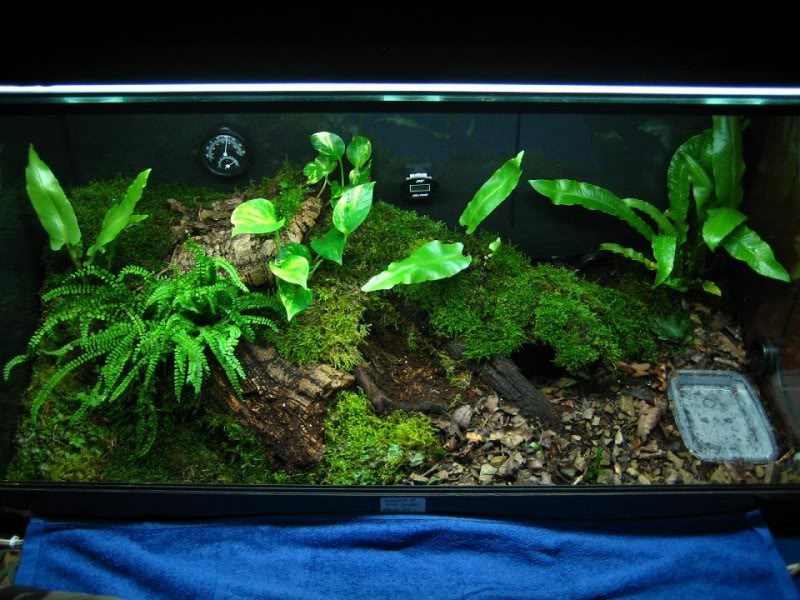junosama
Centruroides
Number of posts : 128
Age : 39
Registration date : 2011-05-16
 |  Subject: Theraphosa blondi Subject: Theraphosa blondi  11/21/2011, 1:51 am 11/21/2011, 1:51 am | |
| Anyone have any tips for caring for this tarantula? I have a big breeder tank I am thinking of putting one in. Links to accurate care sheets would be appreciated as well. Thanks Also if you have one please post a pic of the habitat! | |
|
*~BEX~*
Administrator

Number of posts : 4246
Age : 41
Registration date : 2010-08-29
 |  Subject: Re: Theraphosa blondi Subject: Re: Theraphosa blondi  11/21/2011, 6:38 am 11/21/2011, 6:38 am | |
| Theraphosa blondi - Goliath Bird Eating TarantulaRegions Found: Venezuela, Northern Brazil, Guyana, French Guiana and Suriname. Class: Terrestrial and ground dwelling Longevity: Reach maturity in 3-5 years and females can live to 25 years, whereas males will die shortly after reaching maturity Adult Size: Leg span of 25-30cm Temperament: Very aggressive and will make defensive hissing noises Urticating Hairs: Yes and lots of them Venom Potency: Strong and painful Theraphosa blondi Housing RequirementsTarantula Housing: Floor space is more important than height, a deep substrate should be provided for burrowing. A good retreat is required. Temperature: 24-28°C (75-82°F) Humidity: About 80% Special Requirements: Humidity needs to be increased near a moult to prevent problems Breeding Theraphosa blondi TarantulasBreeding Difficulty: Difficult Egg sac size: 50-150 Danger to Male: Possible sexual cannibalism Theraphosa blondi DietLivefood insects such as crickets, locust, butter worms, meal worms, superworms, The Goliath Bird-eating spider is large and very stocky spider with a broad carapace, thick legs, and a large abdomen. It is a terrestrial species and has evolved to this large, heavy body type living in the humid burrows of the tropical forests of South America. They are a hairy, light-brown coloured spider with a leg span that can extend up to about 25 cm (10 inches) but can be up to 30.5 cm (12 inches).
Though the male and female are very similar, a mature male will be more slender and long-legged, as with other species of tarantula. They mature at about 3 to 4 years and females can live for up to 25 years while males live just past reaching maturity.
Adult Goliath's can be kept in a converted aquarium with approximately 2-3 square feet of floor space. You should add at least 20 cm (8 inches) of substrate (peat moss or cypress mulch are recommended) and allow this terrestrial species to dig a burrow. A large shelter can be offered in the form of a cork bark cave or a half-buried clay pot.
Spiderlings will generally be semi-arboreal until they are strong and large enough to begin burrowing into the substrate. They will climb, so a piece of cork bark would make a nice web anchor. They can be kept in small containers such as pill tubs and waxworm tubs and slightly larger species can be kept in livefood tubs. Use moistened peatmoss or similar substrate to ensure the humidity levels are correct.  The Goliath Bird Eating Tarantula requires a temperature range of 24-28°C (75-82°F). At night a temperature drop of up to 6°C (10°F) may be useful to best recreate the natural daily cycles that a spider would encounter in the wild. The Goliath Bird Eating Tarantula requires a temperature range of 24-28°C (75-82°F). At night a temperature drop of up to 6°C (10°F) may be useful to best recreate the natural daily cycles that a spider would encounter in the wild.
The use of heat mats or under tank heating (UTH) will increase substrate temperatures, whereas lamps will increase air temperatures. You can use both these apparatus along with thermostats to control the temperature within the vivarium. The warmer you keep your tarantula, the higher its metabolic rate will be, the higher the humidity will be and the faster the substrate will dry out. Keeping a tarantula at a lower temperature is not necessarily a bad thing.
T. blondi is a rainforest species and they require high humidity levels of above 80%. It is important to keep the humidity high or this tarantula will not live very long. A mix of peatmoss and water, combined with under tank heating and a large shallow water bowl should help to provide these high humidity levels. A hygrometer can be used to measure relative humidity within the enclosure and additional humidity can be provided by misting the tank regularly with a misting bottle. Reducing ventilation may seem an easy way to increase the humidity but this can also lead to the air in the vivarium becoming stagnant which will without a doubt lead to the death of any pet tarantula.
This specimen is powerful enough to feed on frogs, toads, lizards, mice, snakes and even birds, although in captivity these tarantulas should diet on mainly small insects such as crickets, locust and beetle larvae.
Similarly to other tarantulas, the bird eating tarantula will eat insects, reptiles and small rodents up to their own size. Suitable insects include crickets, moths, beetle larvae (meal worms and superworms), houseflies and cockroaches. Although they may take on rodents and reptiles in the wild it is not recommended you feed them in captivity, for complications may arise such as a fatal bite by the food item itself.
When feeding livefoods, although it may be fun, try not to over challenge your Bird Eater by giving it food items that are too large. Stick with something about half the size of the tarantula and remove uneaten food items so they do not cause harm or stress.
Spiders usually eat massive amounts post-moult until they are full, this is called power feeding. They will refuse food pre-moult or when ready to lay an egg sac. It usually takes about 1 week to 1 month for a Theraphosa blondi to accept food after a moult, because of the skin and fang hardening process. You can’t really over feed a tarantula, but this doesn't mean you should overdo it by giving it 50 crickets after a moult; the tarantula will probably end up killing them all and leaving dead ones uneaten. If this is the case then they should be removed to prevent bacteria and mould growth. The other factor is that a plump abdomen is more prone to rupture if this species falls from a height.
Theraphosa blondi are sometimes troublesome to feed as they will spend a long time down in burrows and it’s just not possible to know if a missing food item has been eaten or is rotting in the burrow. To encourage feeding try to drop the food items near to the tarantula and so that it lands on the web at the entrance to the burrow. Hopefully you will see the Bird Eating Tarantula jump out and grab it.
The Goliath Bird Eater is notorious for its moulting problems. A significant number of T. blondi will die as juveniles through getting stuck in a moult or simply damaging themselves while moulting. This is one reason why the humidity should be maintained at a high level, as humidity softens the moulted exoskeleton allowing it to be removed.
| |
|
**GS**
Leiurus

Number of posts : 2629
Age : 42
Location : facebook.com/ScorpionArchives
Registration date : 2010-09-06
 |  Subject: Re: Theraphosa blondi Subject: Re: Theraphosa blondi  11/23/2011, 5:38 am 11/23/2011, 5:38 am | |
| This is a detailed write-up and one of the best T enclosure i've seen!
| |
|
*~BEX~*
Administrator

Number of posts : 4246
Age : 41
Registration date : 2010-08-29
 |  Subject: Re: Theraphosa blondi Subject: Re: Theraphosa blondi  11/23/2011, 6:02 am 11/23/2011, 6:02 am | |
| Can't take credit for it I'm afraid I just pinched info from places and the pic lol thought it would be better than just pointing them in the right direction so we have a care sheet on the forum for future ref  | |
|
junosama
Centruroides
Number of posts : 128
Age : 39
Registration date : 2011-05-16
 |  Subject: Re: Theraphosa blondi Subject: Re: Theraphosa blondi  12/2/2011, 1:38 am 12/2/2011, 1:38 am | |
| Sorry for the late response, but thanks! | |
|
swane
Pandinus
Number of posts : 45
Age : 47
Registration date : 2011-06-14
 |  Subject: Re: Theraphosa blondi Subject: Re: Theraphosa blondi  12/11/2011, 4:57 pm 12/11/2011, 4:57 pm | |
| very nice set up,the only other set up i saw for the mighty goliath was near me in a petshop and the substrait was sopping wet and no hide for the spider,you could make mud pies with the coco fibre. | |
|
Sponsored content
 |  Subject: Re: Theraphosa blondi Subject: Re: Theraphosa blondi  | |
| |
|

